|
|
I'm increasingly fascinated by the ways in which climate change works hand in hand with, and even directly leads to, geographic change, or the physical alteration of existing landscapes. What interests me even more, however, is the idea that landscape change can sometimes come first – a volcanic eruption, or a redirected river – sending the Earth's climate out of wack. 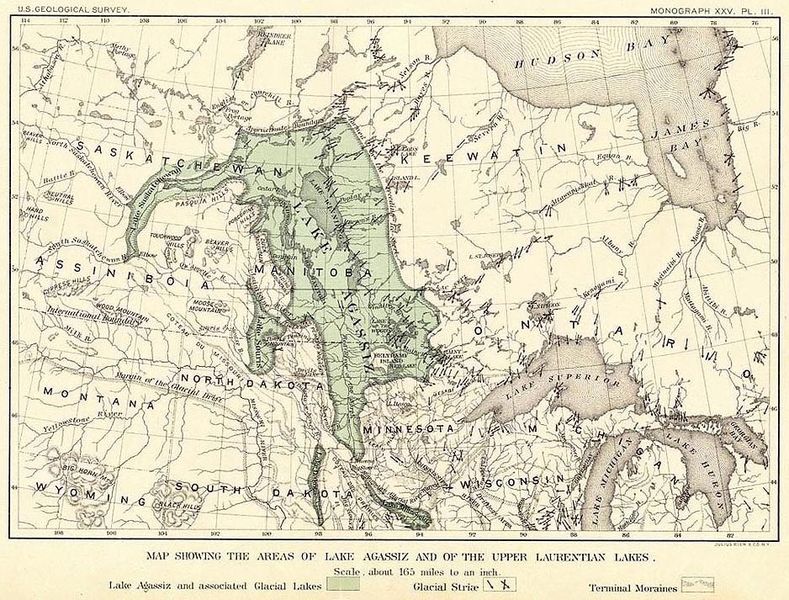 [Image: Lake Agassiz, an ancient glacial lake whose draining may have changed the global climate]. [Image: Lake Agassiz, an ancient glacial lake whose draining may have changed the global climate].Roughly 13,000 years ago, for instance, Lake Agassiz, a gigantic freshwater lake "bigger than all of the present-day Great Lakes combined," broke through its ice dam and flooded up the St. Lawrence Seaway, roaring directly into the Atlantic. As a result, certain oceanic currents shut down and the existing pattern of global temperatures changed in a matter of months. Or another example: 55 million years ago, the "volcanic eruptions that created Iceland might also have triggered one of the most catastrophic episodes of global warming ever seen on Earth," New Scientist reported last week. In other words, the formation of Iceland was "accompanied by violent volcanic eruptions that built layers of basalt rock 7 kilometres thick." (!) All that new rock packed "a total volume of 10,000,000 cubic kilometres, enough to build a proto-Iceland in the newly-born north Atlantic." In the process, though, this "huge volcanic eruption... unleashed so much greenhouse gas into the atmosphere that world temperatures rose by as much as 8°C." The effect "was disastrous for most life... killing off many deep-sea species." 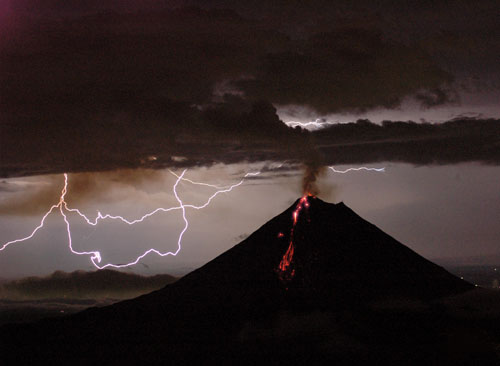 [Image: The completely unrelated, but nonetheless beautiful, Arenal Volcano in Costa Rica]. [Image: The completely unrelated, but nonetheless beautiful, Arenal Volcano in Costa Rica].On the other hand, these sorts of changes can obviously work both ways: climate change comes first, affecting rainfall, thus forming deserts where there were once great plains – or any variety of other global warming scenarios. In an article in The Guardian last week, Mark Lynas explained how the Sand Hills of Nebraska were once part of a vast desert, larger than the Sahara – "an immense system of sand dunes that spread across the Great Plains from Texas in the south to the Canadian prairies in the north," Lynas writes. But if you overlook the existence of federal irrigation projects, and other government water subsidies, the only major difference between then and now is 1ºC. In other words, it's only one degree cooler today than it was when huge sand dunes roamed across North America. Meanwhile, Lynas goes on to explore how, with every jump of only 1ºC in the average planetary temperature today, wildly different landscapes become possible around the world. The one possibility that truly blows me away – and even makes me want to make a science fiction film, or write a graphic novel, or even publish a BLDGBLOG book of short stories set in this insane new landscape – is this: once Europe is 4ºC hotter than it is today, "new deserts will be spreading in Italy, Spain, Greece and Turkey: the Sahara will have effectively leapt the Straits of Gibraltar." Imagining the cities of northern Italy buried in sand – with Renaissance statuary chest-deep in dunes...  [Image: The Sahara desert, waiting to spring upon the unsuspecting streets of Paris... Via Wikipedia]. [Image: The Sahara desert, waiting to spring upon the unsuspecting streets of Paris... Via Wikipedia].Lynas continues: In Switzerland, summer temperatures may hit 48ºC, more reminiscent of Baghdad than Basel. The Alps will be so denuded of snow and ice that they resemble the rocky moonscapes of today's High Atlas – glaciers will only persist on the highest peaks such as Mont Blanc. The sort of climate experienced today in Marrakech will be experienced in southern England... And so on. However, I don't mean to celebrate the annihilatory effects of global climate change here; I simply mean to point out that: 1) some of these changes are deliriously surreal and, as such, they're actually quite fun to think about; and 2) a very, very strange future awaits our descendents, should anything even remotely like this come to pass. Actually, 3): it's also worth pointing out that, today, a novel set in an abandoned Rome, crawling with sand dunes, would be considered a work of science fiction – but, in one hundred years' time, such a setting may be much closer to social realism. In other words, literary genres will also be forced to adapt in an era of rapid climate change. (This same topic is actually discussed in BLDGBLOG's forthcoming interview with novelist Kim Stanley Robinson). Finally, all of these speculative landscapes of the future have already begun to inspire something of a new golden age for international law. The future of Canada's " Northwest Passage" is a perfect example of this. As ice continues to thaw throughout the Canadian Arctic, a fantastically convenient shipping route, reaching from the Atlantic through to Asia, is taking shape. This route cuts right through Canada's sovereign terrain – but, with such huge sums of money at stake for international trade, will the Canadian government be able to maintain control over the seaway...? The question, then, involves whether the Northwest Passage should be considered a "transit passage" – and, thus, subject to Canadian law – or an "international strait" – thus, outside of Canada's reach.  [Image: The Northwest Passage, as imagined by Sir John Ross, 1819]. [Image: The Northwest Passage, as imagined by Sir John Ross, 1819].According to a recent essay in the London Review of Books, "Canada claims that the passage constitutes Canadian internal waters" – but the United States, perhaps unsurprisingly, "insists that the passage is an 'international strait'." However, the essay goes on to explain that treating the Passage as an international strait – which means it will be free from Canadian regulations, controls, and other legal constraints – may actually pose unexpected consequences in the realm of international security. Anyway – etc. etc. Basically, what I think is cool here is that large-scale terrestrial transformation in an era of rapid climate change is already beginning to impact upon fantastically mundane questions – of law, property, sovereignty, and so on – showing that no matter how sci-fi a situation may likely be, you can always find some way to fit it into human legislation. In any case, I'm sure I'll be returning to this topic soon.
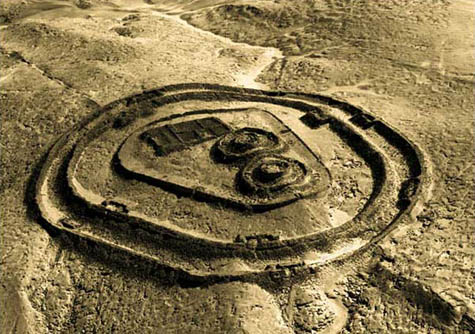 [Image: The solar-aligned ruins of Chankillo, Peru; via the BBC]. [Image: The solar-aligned ruins of Chankillo, Peru; via the BBC].The Chankillo ruins, near the Peruvian coast, made the news a few months back when they were discovered to be an ancient solar observatory. According to NASA, some archaeologists "have nicknamed the ruin’s central complex the 'Norelco ruin' based on its resemblance to a modern electric shaver." Just southeast of the "electric shaver," however, are a series of structures called "the Thirteen Towers, which vaguely resemble a slightly curved spine." 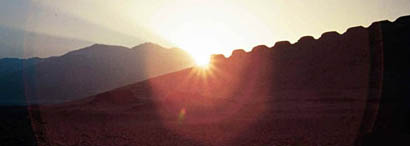 [Image: Photo by Ivan Ghezzi, demonstrating solar alignments with the "slightly curved spine" of the Thirteen Towers; via the BBC]. [Image: Photo by Ivan Ghezzi, demonstrating solar alignments with the "slightly curved spine" of the Thirteen Towers; via the BBC].Quoting NASA: The Thirteen Towers were the key to the scientists conclusion that the site was a solar observatory. These regularly spaced towers line up along a hill, separated by about 5 meters (16 feet). The towers are easily seen from Chankillo’s central complex, but the views of these towers from the eastern and western observing points are especially illuminating. These viewpoints are situated so that, on the winter and summer solstices, the sunrises and sunsets line up with the towers at either end of the line. Other solar events, such as the rising and setting of the Sun at the mid-points between the solstices, were aligned with different towers. The BBC quotes a man called Clive Ruggles, professor of archaeoastronomy in Leicester, England: "These towers have been known to exist for a century or so. It seems extraordinary that nobody really recognised them for what they were for so long." 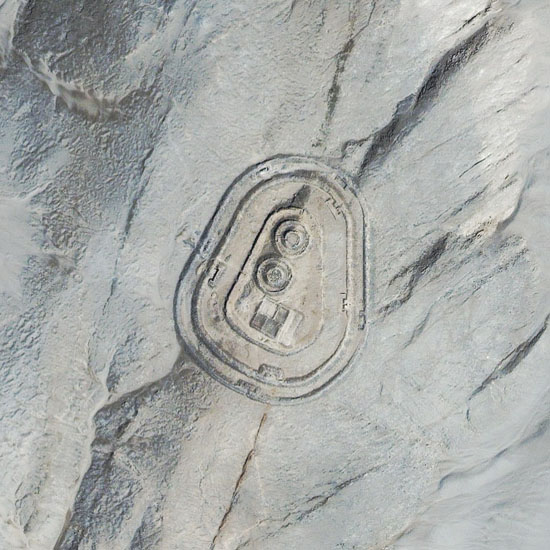 [Image: Like some kind of machine embedded in the surface of the earth, it's the Chankillo Observatory. Courtesy of GeoEye/SIME, via NASA's Earth Observatory]. [Image: Like some kind of machine embedded in the surface of the earth, it's the Chankillo Observatory. Courtesy of GeoEye/SIME, via NASA's Earth Observatory].For all that, though, the surrounding landscape at Chankillo is itself just extraordinary; you can't see it in the images above, however, so take a look at this image – or even at this huge version of that image, or even at this truly gigantic (3.4mb) version. Meanwhile, I'm a genuine sucker for solar-alignment theories involving landscapes and architecture; in fact, I was just talking to someone about this the other day. Yet I'm even more of a sucker for unintentional examples of such things – like houses with pitched gable roofs that accidentally line-up with the sun every summer solstice... I've talked about this kind of thing on BLDGBLOG before – but that doesn't mean I won't do it again. For instance: one day, a science writer in her late 30s gets an email saying that she's being sent to report on iceberg calving off the western coast of Greenland. She takes a boat, along with some climate scientists and oceanographers, and they find themselves inside the region of study by the second week of June. Icebergs are flowing past the ship on all sides; no one can believe how many there are. Measurements are taken; the icebergs continue to drift. The days grow longer. 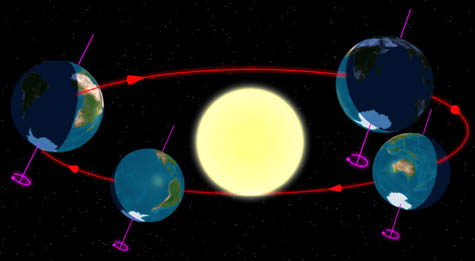 [Image: Via Wikipedia]. [Image: Via Wikipedia].Then, on the morning of the summer solstice, our science journalist can't sleep. She's been up all night, flipping her pillow over and back, shoving the blankets off then pulling them tight again, etc. etc. Finally, she gets out of bed and wanders out onto the deck of the ship – where she sees the sun of the summer solstice just hanging there. Incredibly, though, a perfect line of drifting icebergs – ten, twenty, thirty icebergs – stretches out, one after the other, toward the horizon. The effect is uncanny; it looks as if the icebergs have been deliberately placed there, sculpted into an unbroken line by unseen forces – and right above them, of course, is the summer sun, casting a reflective line of golden light from one icy peak to the next. It's as if, for that precise moment, from the deck of that particular ship, for that one woman alone, the Arctic seascape has been arranged to line up with the solstice. In any case, I think there should be an ongoing competition – or at least some kind of internet archive – for photographic proof of unexpected solar alignments: four times a year, perhaps – on the solstices and equinoxes – you go out and search for weird alignments of the sun... In a small town outside Albany, the windows of every house in one particular cul-de-sac light up, the sun shining straight through house after house, in a perfectly straight line, as if they'd been built for the purpose, a monumental solar observatory the exact size and shape of suburbia – till one family closes their curtains, and the effect is gone. (Earth Observatory image found via del.icio.us/pruned).
"The California prison system," as reported by The New York Times today, is "severely overcrowded, teeming with violence and infectious diseases and so dysfunctional that much of it is under court supervision." As such, it is a system "that anyone with the slightest means would most likely pay to avoid." Luckily for them, they can now do so.  They can pay-to-stay: For offenders whose crimes are usually relatively minor (carjackers should not bother) and whose bank accounts remain lofty, a dozen or so city jails across the state offer pay-to-stay upgrades. Theirs are a clean, quiet, if not exactly recherché alternative to the standard county jails, where the walls are bars, the fellow inmates are hardened and privileges are few. For fees ranging from $82 to $127 per night, inmates can apparently stay for up to four years. The NYTimes reports on one "prisoner," in particular, "who in her oversize orange T-shirt and flip-flops looked more like a contestant on The Real World than an inmate." They quote her: "I haven’t had a problem with any of the other girls. They give me shampoo.” In what is surely the set-up for a new blockbuster comedy – starring Jim Carrey – we even learn that many pay-to-stay convicts are actually "granted work furlough, enabling them to do most of their time on the job, returning to the jail simply to go to bed." There are obvious – and entirely justified – complaints: for instance that this system simply transforms the Californian penal system into a new kind of sociological adventure tourism, favoring those residents of the state with enough disposable income to avoid showering alongside gangs of neo-Nazis – totally violating any concept of punishment or rehabilitation in the process. At the same time, though, sociological adventure tourism opens up a fascinating range of future business models that we would do well to think about, and prepare for, before they come to pass. Pay-to-stay loans, for instance, or jail'otels – or even some weird outer Hollywood casting agency where you can try out for substitute imprisonment on behalf of paying clients. Should you be accepted, they'll take care of your student loans and buy your family weekly pizzas. Though I'm sure you can already be hired to go to jail. Read more at The New York Times.
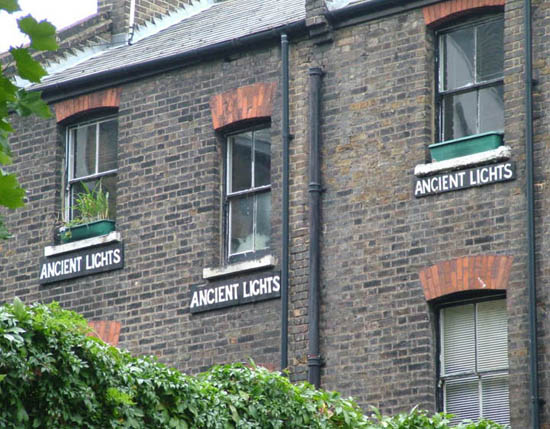 [Image: Via Wikipedia]. [Image: Via Wikipedia]."Ancient lights" is a colloquialism for the " right to light," guaranteed under English law, whereby windows that have seen twenty years' worth of "uninterrupted" daylight cannot be blocked by the construction of new buildings. Or, as Wikipedia explains it: In effect, the owner of a building with windows that have received natural daylight for 20 years or more is entitled to forbid any construction or other obstruction that would deprive him of that illumination. Neighbors cannot build anything that would block the light without permission. The owner may build more or larger windows but cannot enlarge his new windows before the new period of 20 years has expired. "Once a right to light exists," we read, "the owner of the right is entitled to 'sufficient light according to the ordinary notions of mankind'." Even better, British courts apparently "rely on expert witnesses to define this term." Whether "this term" refers to sufficient light or to ordinary notions of mankind is hard to tell. In any case, the Royal Institution of Charted Surveyors, or RICS, suggests that you should never "settle for living in the shadows." The RICS believes, in fact, that "many people are allowing adjacent buildings to block their natural light, unaware that they have a legal right to it. Light blocking can be classified as a ‘nuisance’ alongside noise and air pollution and culprits range from large new commercial developments to a neighbour’s building extension or a new garden shed. Even a tall hedge can be a problem." The tone of the RICS abruptly shifts at this point, however, as they begin to explain how you can actually prevent your neighbors from acquiring ancient light rights. There is a "need for vigilance to prevent neighbours acquiring a right to light," they warn; after all, such an acquisition "may hamper future development and investment possibilities" on your own property. "It is possible to prevent a building acquiring a right to light," the RICS explains, "but despite the procedure being simple, it is rarely used." The "procedure" involves a man called Vinnie, and he – The actual solution is a kind of ghost architecture. In other words, following consultation from the RICS, you draw "a notional screen of unlimited height," along with other "imaginary legal partitions," around your home, thus defining the light rights of your property. You then ring your neighbor's doorbell, hand him an envelope, and explain what you've been doing. He nods quietly, ceases construction on his new guest bedroom – and then throws a brick through your window. You retaliate. The other neighbors soon join in, choosing sides, talking strategy, letting the air out of your car's tires and stealing your newspaper. Within a week, the quality of life on your street has plummeted; there are threats, loud noises, and an unexplained smell... Meanwhile, "[i]n the center of London, near Chinatown and Covent Garden, particularly in back alleyways, signs saying ' Ancient Lights' can be seen marking individual windows." ('Ancient Lights' found via del.icio.us/fakeisthenewreal).
 [Image: Scotland Street Tunnel, Edinburgh, as photographed by Nick Catford]. [Image: Scotland Street Tunnel, Edinburgh, as photographed by Nick Catford].
It's always worth checking in to see what Subterranea Brittanica have been up to – especially when they've been to such places as the Hanover Chalk Mine or the Scotland Street Tunnel – so I thought I'd take a quick look at some of the things now up on their site.
First of all, starting with the Scotland Street Tunnel, we find ourselves in Edinburgh, walking down through a former railroad tunnel that "measures 1000yds in length, 24ft in width, and 24ft in height with a gradient of 1-in-27 towards the north. The roof of the tunnel is just below street level at Scotland Street," they write, "but is 49 feet deep at St. Andrew Street and 37 feet deep under Princes Street." 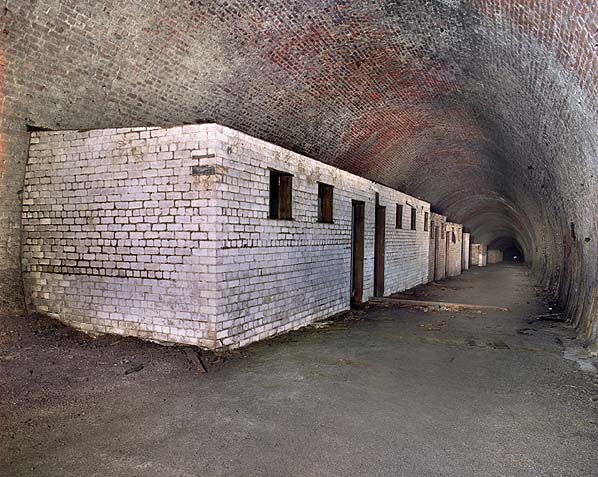 [Image: Scotland Street Tunnel, Edinburgh, as photographed by Nick Catford]. [Image: Scotland Street Tunnel, Edinburgh, as photographed by Nick Catford].In their field notes, our guides at Subterranea Brittanica quote novelist Robert Louis Stevenson: The tunnel to the Scotland Street Station, the sight of the trains shooting out of its dark maw with the two guards upon the brake, the thought of its length and the many ponderous edifices and open thoroughfares above, were certainly of paramount impressiveness to a young mind. Not surprisingly, the site was re-used during WWII as an air raid shelter, forming what's referred to as a "hardened emergency control centre." Post-war, then, the tunnel went on "to house... a traffic office with centralized traffic control. The traffic controller had telephone links to all signal cabins, goods yards and major stations and offices" in the city. This latter function partially explains the brick structures that were built inside the underground space. Awesomely, we read, in the 1970s "the tunnel was used for growing mushrooms" – before it was then "used as a location for monitoring natural radiation." Don't eat those mushrooms! 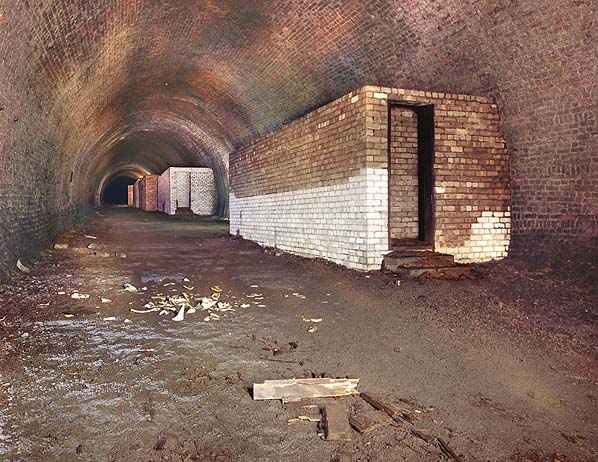 [Image: Scotland Street Tunnel, Edinburgh, as photographed by Nick Catford]. [Image: Scotland Street Tunnel, Edinburgh, as photographed by Nick Catford].Many more images of the tunnel – all of which were taken by Nick Catford – including a lot more information, can be found at the bottom of this page. Meanwhile, there's the Hanover Chalk Mine in Reading, England. Access to the mine, we're told, can be "arranged via the [local] caving club." You physically enter the space by way of "a 50ft fixed steel ladder in a narrow vertical shaft below a locked iron cover." In other words, you lift the iron cover – and descend into the surface of the earth. 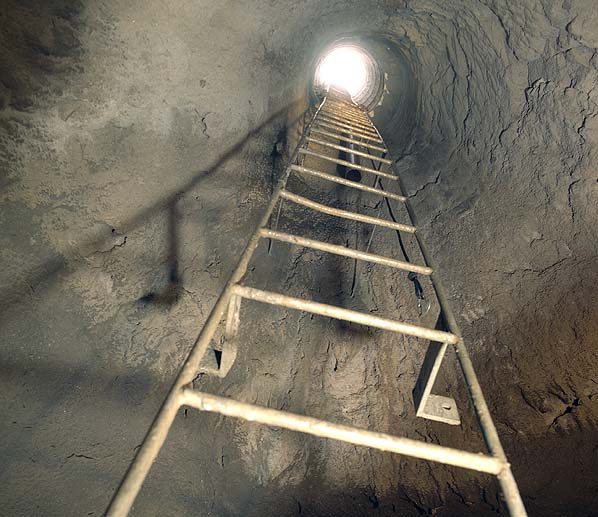 [Image: Hanover Chalk Mine, as photographed by Nick Catford]. [Image: Hanover Chalk Mine, as photographed by Nick Catford].
The Hanover Chalk Mine was apparently "rediscovered" in 1977, after which "a new lining was installed in the shaft, and the workings inspected and surveyed." Subterranea Brittanica themselves found that the mine "is generally very dry, with no obvious evidence of water seeping in through the ceiling or standing on the floors." 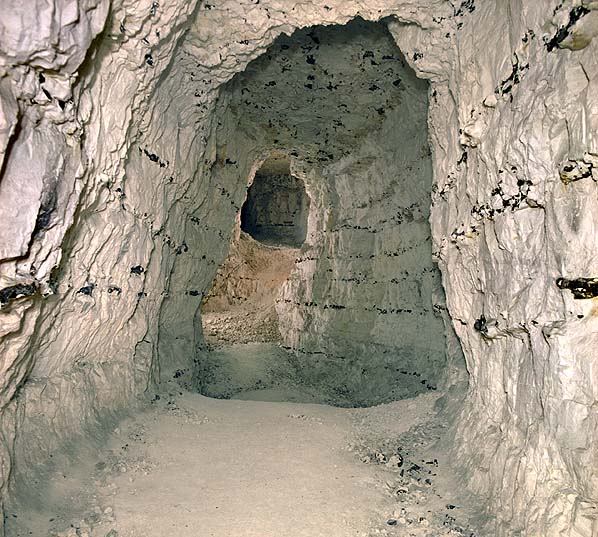 [Image: Hanover Chalk Mine, as photographed by Nick Catford]. [Image: Hanover Chalk Mine, as photographed by Nick Catford].However, judging from small piles of rubble, some structural instability in the walls apparently relieved itself long ago through a partial collapse; this partial collapse is beautifully referred to as "an upwardly migrating void" that may yet cause "other collapses of the surface." 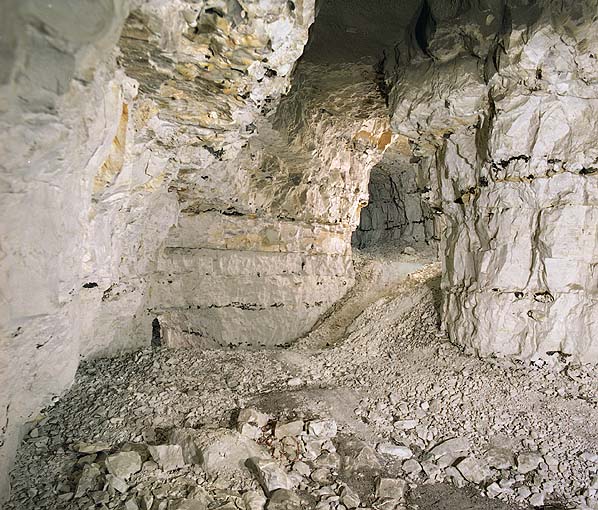 [Image: Hanover Chalk Mine, as photographed by Nick Catford]. [Image: Hanover Chalk Mine, as photographed by Nick Catford].Though it's divided up into northern and southern branches, each excavated for slightly different purposes, the mine has not always been a mine. "One or both of the interlinked northern mines," we read, "are known to have been used for the secure storage of documents by Reading Council during World War II, and two corrugated iron shelters, a brick-built stove and chimney, and tea-chests are said to remain below ground. One of the shafts reportedly contains timber staging, and one is said to be 70 feet deep." So where did all this chalk come from? In his fantastically great book Earth, writer and natural historian Richard Fortey takes us on an imaginary aerial tour of the planet, drifting in a full circle around the globe. During the tour, Fortey describes how we look down from great heights at the vast folded belts of continental plates, from buckled ridges and alluvial plains to tropical islands, Himalayan plateaus, and Pacific trenches – including, at one point, the ancient chalk landscapes of southern England. Quoting Richard Fortey at great length: Imagine flying higher and higher, until we can see that all the fine hotels and monuments and endless suburbs of London lie in a bowl of strata of Tertiary age. The River Thames is now no more than a silvery line following the centre of the bowl. Beneath these strata – mostly soft sands and clays – there are older rocks again; the white Cretaceous limestone known as the Chalk reaches the surface north and south of London on open downs, where sheep were once universal... South of the London Basin, the Chalk frames the Weald, which was the major source of iron in medieval times and now is thick with groves of sweet chestnut burying ancient hammer ponds. From high up, most of what you see is forested. Climb higher still and we can see that the Chalk, again, forms the white cliffs of Dover – to many English people perhaps the most sentimentally significant piece of geology there is. From this height we can see that the Dover cliffs are of a piece with facing cliffs in France on the other side of the English Channel, which is nothing more than a geological afterthought, breached by the eroding sea just a few thousand years ago. Geology knows no national boundaries and from here we can even make out the Chalk extending far across France, to underlie the endless plains in the north, where the grain that goes into making 100 million baguettes is grown in fields that have neither hedgerows nor apparently any end. And could we but follow the Chalk around the world we would find similar white limestones stretching from the Canadian Shield "all the way through to Texas and Mexico," as [Eduard] Suess said, to the Black Sea and well beyond in the Middle East. Chalk rock records one of the great transgressions of the sea onto the continents, one which happened close to 100 million years ago, and which painted great slabs of the world white for eternity with the sediment it left behind. It seems a little strange to use the word "eternity" there, in a book that is, ostensibly, a very literate demonstration that nothing lasts forever in the world of tectonic geology; but that's a minor quibble. 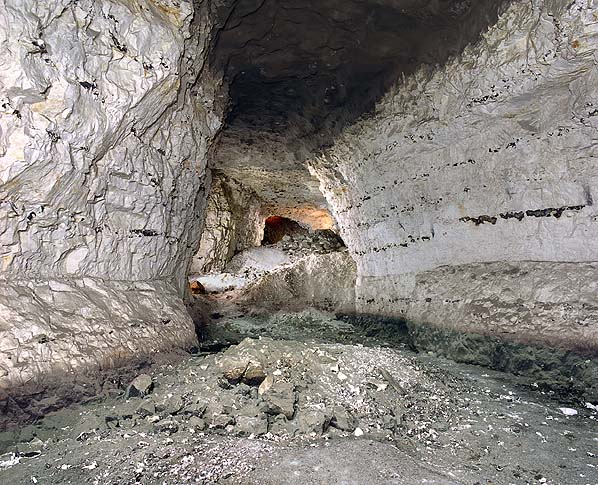 [Image: Hanover Chalk Mine, as photographed by Nick Catford]. [Image: Hanover Chalk Mine, as photographed by Nick Catford].I think it's more important simply to point out that these rocks, seamed with flint, so ready to form caves and pockets beneath the everyday landscape we normally walk upon, thinking more often about what lies ahead than what lies below, have an incomprehensibly specific and ancient history behind them. If it wasn't for lost seas, nearly saturated with life, slowly depositing meter upon meter of organic matter in quiet bays and inlets and coves, this chalk would never have formed – and, of course, this mine would never have existed. These photographs thus capture the almost unimaginably distant side-effects of landscapes that no longer exist – side-effects which have themselves come to form landscapes, in fact the very terrain that grounds our present era. The history beneath that ground is indeed a kind of abyss. Finally, while you're clicking around through Subterranea Brittanica, don't miss the artificially underground surreality of Barons' Cave. "Nobody knows how old The Barons' Cave is," we read. "The oldest reference to it dates from 1586 when Camden describes 'an extraordinary passage with a vaulted roof hewn with great labour out of the soft stone.'" 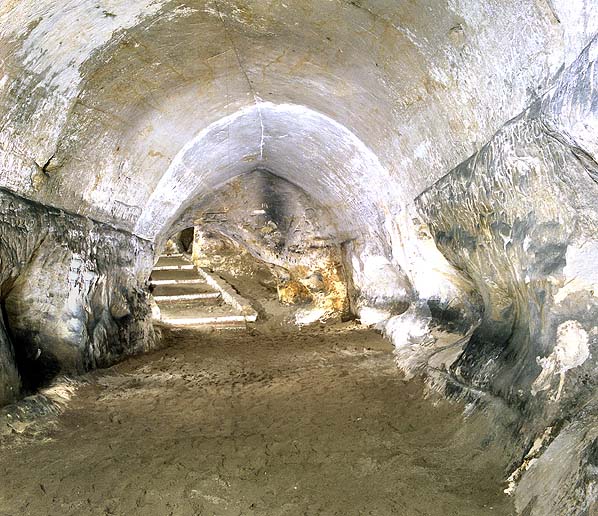 [Image: Barons' Cave, as photographed by Nick Catford]. [Image: Barons' Cave, as photographed by Nick Catford].The various photos of Barons' Cave are well worth checking out – including close-ups of graffiti left by visitors who missed one another by hundreds of years. (All images in this post are by Nick Catford, who holds the copyrights, etc. etc., and deserves loads of credit for the amazing work).
 [Image: The interior of the Pantheon, as photographed by Soeren Dalsgaard]. [Image: The interior of the Pantheon, as photographed by Soeren Dalsgaard].An anonymous reader pointed out that the Pantheon was featured in NASA's Astronomy Picture of the Day last Friday. "A testament to Roman architecture and engineering," NASA writes, "the Pantheon's dome is said to symbolize the vault of the heavens." 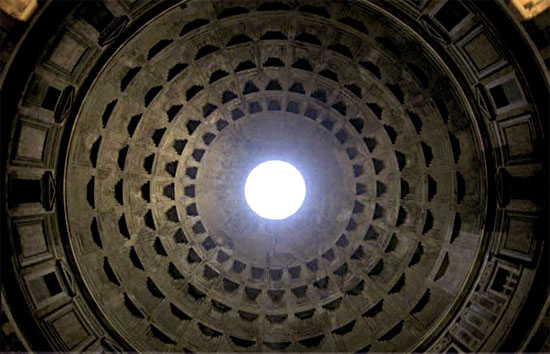 [Image: A "celestogramme," looking up from within at the dome of the Pantheon, by Wolfgang Wackernagel]. [Image: A "celestogramme," looking up from within at the dome of the Pantheon, by Wolfgang Wackernagel].Seeing that, of course, makes it impossible for me to resist referring you back to BLDGBLOG's interview with Walter Murch, posted two weeks ago, in which Murch postulates a possible connection between the physical structure of the Pantheon itself and the heliocentric astronomical theories of Nicolaus Copernicus. In other words, does the dome of the Pantheon "symbolize the vault of the heavens," as NASA writes, but in an unexpectedly literal way? In the interview, Murch explains how he "superimposed Copernicus’s drawing [of the planetary orbits] over an image of the Pantheon’s dome – and found that the ratios of the circles in his drawing and the ratios of the circles of the Pantheon line up almost exactly. Seeing that alignment was one of those wonderful moments where you suddenly feel a strong current of connection with the past." 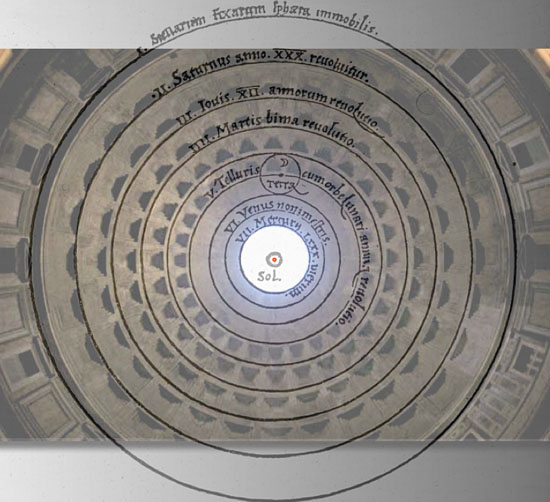 [Image: Superimposition, by Walter Murch, of Copernicus's diagram of planetary orbits over a celestogramme of the Pantheon by Wolfgang Wackernagel]. [Image: Superimposition, by Walter Murch, of Copernicus's diagram of planetary orbits over a celestogramme of the Pantheon by Wolfgang Wackernagel].So is it just an interesting coincidence? Murch goes on: The circumstantial evidence [for a real connection between Copernicus's drawing and the structure of the Pantheon] is compelling, but there is no reference to the Pantheon in any of Copernicus’s correspondence or in the various manuscript versions of de Revolutionibus – so we will probably never know for sure.
Nonetheless, it’s a fascinating thought: that this magnificent temple, built 1400 years before Copernicus ever saw it, designed by a pagan, Sun-worshipping Roman emperor, and later transformed into a church, may have had secretly encoded within it the idea that the Sun was the center of the universe; and that this ancient, wordless wisdom helped to revolutionize our view of the cosmos. If you haven't seen the interview yet, be sure to check it out. It's worth the read.
Can UPS save millions of dollars on truck fuel simply by cutting down on its drivers' left turns? Apparently, the company has been trying "to re-engineer their fleet routing," the Financial Times reported last month, as a way to find more fuel-efficient modes of delivery – and part of this means they're now limiting left-hand (or cross-traffic) turns.  As the Financial Times explained: [I]nformation technology has an important role to play in making existing vehicles more efficient, particularly when it comes to aggregating small gains across large fleets. Take something as simple as reducing left-hand turns. For US drivers, this means less time idling in the middle of the road waiting for oncoming traffic to pass. UPS route engineers are thus relying on "an underlying map database that can penalise or disable left-hand turns in the route planning process. The system is well suited to the delivery business because drivers can run circular routes, ending up where they started." The FT goes on to explore the fuel-use implications of just-in-time delivery; air & truck delivery vs. water & rail transport; a "computer model that would create commercial freight routes in the way that MapQuest or Google Maps make maps for motorists"; and something called Gift: the Geographic Intermodal Freight Transport model.  Elsewhere, sudden transformations of the earth's surface, as a result of mudslides, floods, volcanic eruptions, and other topographical catastrophes, can make existing maps obsolete within seconds. This is precisely what happened several weeks ago when an earthquake struck on the floor of the south Pacific, off the coast of the Solomon Islands, near Australia, raising coral reefs several meters out of the water – thus killing the reefs and creating a new, sun-bleached archipelago. "Submerged reefs that once attracted scuba divers from around the globe lie exposed and dying after the quake raised the mountainous landmass, which is 32-kilometres (20-miles) long and 8-kilometres (5-miles) wide," Seed magazine reported. The sudden terrestrial shake-up also "revealed a sunken vessel that locals believe is a Japanese patrol boat, a remnant of the fierce fighting between Allied forces and the Japanese in WWII." Pulp sci-fi novelists may want to bear this in mind when coming up with future storylines. For instance: an earthquake off the coast of Chennai thrusts a submerged geological ridge into the sunlight – revealing an unexplained metallic anomaly within those slabs of shell-encrusted limestone. Scientists called in to investigate are almost immediately hospitalized after visiting the site, suffering from headaches and nosebleeds. Local fishermen report identical symptoms. Instruments, however, record a complete absence of radiation – so there must be something else going on. Intriguingly, the exposed metal structure appears to be growing.... Etc. etc. Like I say: pulp science fiction. Moving on, we learn that geothermal energy is on the rise in southern Germany. 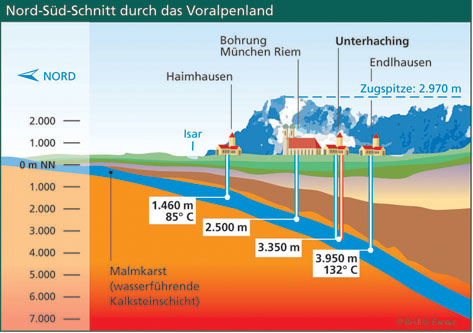 [Image: Alpine geothermics; illustration by Rödl & Partner]. [Image: Alpine geothermics; illustration by Rödl & Partner].According to Monocle, "Munich and its hinterland have become the new frontier for deep-seated geothermal energy": Drilling three to four kilometres into the earth's crust allows engineers to tap into boiling hot water, which can be used to heat buildings and run zero-emission power plants. The southernmost past of the state of Bavaria, along the Alps' foothills, is the literal hotbed of geothermal exploration, with planned investments of €3.2bn. Siemens, unsurprisingly, is fast on the draw, with a new plant already under construction there, in a town called Unterhaching. That same issue of Monocle also points us to the " hexagonal wooden islands" of architect Vicente Guallart (whose work was previously seen on BLDGBLOG here). This "astonishing series of artificial islands," Monocle writes, comes "in two basic forms – flat or 'hillock' – and [they] have been a great success with sunbathing locals." In the architect's own words, these create "multiple coastlines," extending seasonal fun onto previously nonexistent landforms. 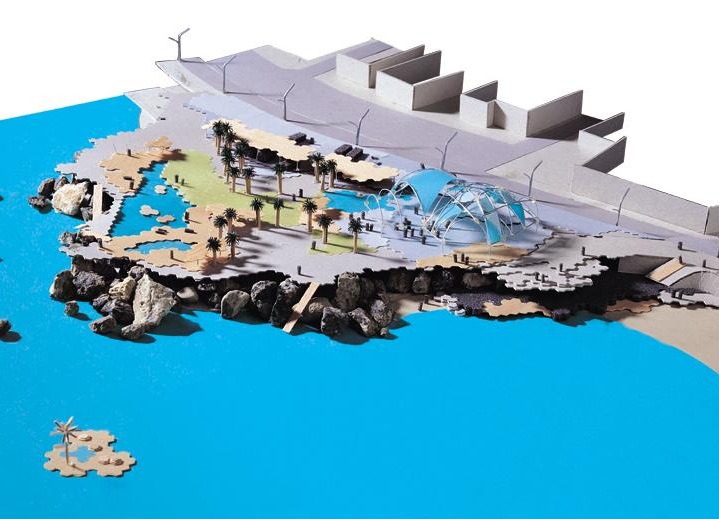 [Image: The hexagonal wooden islands of Vicente Guallart]. [Image: The hexagonal wooden islands of Vicente Guallart]. This also raises the interesting question, though, of designer terrain – or even branded landscapes, specific earthen features associated with, say, Nike or the Hilton Hotel chain – and whether or not terrestrial augmentation, such as Guallart's hexagonal wooden islands, will be the next step in boutique design. Rather than a boutique hotel, in other words, you'd have a boutique landscape. A bit further afield, meanwhile, "shape-shifting 'smart dust' may explore alien worlds," New Scientist reports. Thousands of miniscule wireless sensors, or "smart dust", could one-day be used to explore other planets, swirling across the landscape by subtly altering their shape. These individual pieces of "smart dust" will "navigate by shape-shifting," as they drift in artificial clouds of nanotechnology – implying, incredibly, that machines may someday form entire weather fronts, with their own microclimates and atmospheric effects – crossing extraordinary landscapes, such as the "outcrop called ' Olympia' along the northwestern margin of 'Erebus'," on Mars.  [Image: Olympia Crater, Mars; courtesy of NASA/JPL-Caltech/Cornell]. [Image: Olympia Crater, Mars; courtesy of NASA/JPL-Caltech/Cornell]. Finally, for now, it was announced this week that the US military "is building a three-mile concrete wall in the centre of Baghdad along the most murderous faultline between Sunni and Shia Muslims." The wall, which recognises the reality of the hardening sectarian divide in Baghdad, is a central part of George Bush's final push to pacify the capital. Work began on April 10 under cover of darkness and is due for completion by the end of the month... Although Baghdad is full of barriers and checkpoints, particularly round the Green Zone where the US and British are based along with the Iraq government, this is the first time a wall has been built along sectarian lines. Its construction comes as the security situation appears to be deteriorating despite the recent US troop "surge". The fact that physical structures, such as checkpoints and Bremer walls – in other words, pieces of architecture – are being used "to pacify" Baghdad fascinates me no end. 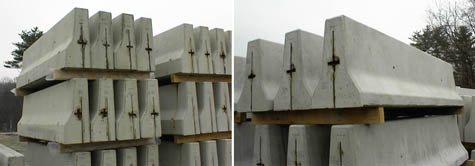 [Images: Concrete barriers (with no connection to Baghdad)]. [Images: Concrete barriers (with no connection to Baghdad)]. Adding to the tactical surreality of this decision – after all, building a wall to separate warring neighborhoods will almost certainly result in more extreme mortar attacks and general social distrust – we find this glimpse of architectural construction under continuous military guard: The Baghdad wall, which will be 12ft (3.5 metres) high, is being built by US paratroopers who left Camp Taji, about 20 miles north of the city, on the first night in a dozen trucks carrying stacks of huge concrete barriers, each weighing 14,000 pounds (6,300kg). Cranes, protected by tanks, winched them into place. Building has continued every night since. The ultimate "strategy" here is to create "a series of gated communities, in which US and Iraqi troops control entry and exits." More soon – and happy Earth Day, by the way. (With two of these links found via Leah Beeferman and Telstar Logistics. Earlier on BLDGBLOG: Quick list 8 – and onward from there...).
"Immense coils of hot, electrified gas in the Sun's atmosphere behave like a musical instrument," the BBC reported yesterday.  Even better, these "'coronal loops' carry acoustic waves in much the same way that sound is carried through a pipe organ." In the process, each micro-flare – released by coronal looping and fueled by "the energy equivalent to millions of hydrogen bombs" – sends "immensely powerful acoustic waves hurtling through the loops at tens of kilometres per second, creating cosmic 'organ music'."  Mixing our musical metaphors here, the sonic effect is then compared to plucking a guitar string – but, judging from this audio excerpt, it sounds more like the rolling percussion of an orchestra being tuned. Of course, solar sounds have been featured on BLDGBLOG before; in Podcasting the sun, for instance, we looked into whether the sun is "ringing like a bell" or "clapping," and the answer seems to be both – only adding to the sun's repertoire of instrumental metaphors.  I would even postulate, given the evidence, that we can only understand the sun through metaphors – comparing it to scientific models, hydrogen bombs, musical instruments, gods and goddesses, etc. – which, as it happens, is the subject of a short essay by Jacques Derrida called " Ellipsis of the Sun" (though I think Paul de Man also has an essay about this – I just didn't bring any de Man books with me to LA...). In any case, I was actually reminded of the "sea organ" in Zadar, Croatia, when I first heard of the sun's coronal symphonies. "Spring 2005 saw Zadar gain something absolutely unique," we read; that "something" was "the world’s first pipe organ that’s played by the sea."  [Images: The Zadar sea organ, from this PDF]. [Images: The Zadar sea organ, from this PDF].The sea organ is appropriately named, then, as the natural motion of the sea "pushes air through" 35 pipes on the coastal edge of the city; at that point, "depending on the size and velocity of the wave," the residents of Zadar can sit back and listen as "chords are played." So could you attach an organ like that to the sun...? That would play continuous solar music and sidereal sounds, reverberating over continents, everyday? A kind of sky piano that rips and roars and shines atonally in chords across the Earth's magnetosphere? And if you stood at the edge of an Alaskan forest, with your antenna pointed up into the sky, headphones on, tuned into that solar presence, entranced, would you hear this? Thus literalizing the BBC's metaphor? If so, would Jacques Derrida be proud? (Note: More sunscapes at Pruned. Zadar sea organ found via the Kircher Society. Ethereal piano MP3, linked at the end of this post, by Myke Weiskopf and his newly revived audio resource ShortWaveMusic).
 [Image: Jeffrey Inaba]. [Image: Jeffrey Inaba].Jeffrey Inaba teaches architectural theory and design studios at Columbia (where he is the founding director of C-Lab) and SCI-Arc (where he and Paul Nakazawa run SCIFI, the Southern California Institute for Future Initiatives); he heads Inaba Projects; and he regularly contributes to a wide variety of publications, not the least of which is Great Leap Forward: The Harvard Design School Project on the City. BLDGBLOG spoke to Inaba about... well, about as many topics as we could fit into one phone conversation: Archigram, sports cars, golf courses, feng shui, Donald Trump, Saddam Hussein, penthouse design and the rise of Tribeca, hedge fund managers, spatial surplus, sustainable development in China, the economics of suburbia and global megaslums, dog training as a political metaphor, science fiction novels as a form of architectural research – etc. etc. It's a fun conversation, if I do say so myself; even better, if you're left wanting more you only have to click through to Archinect, where an ongoing discussion with Ole, Mark, and Jeffrey is even now underway. • • •BLDGBLOG: With Volume 10 you call for more “agitation” in architectural discourse. Could you go into this a bit more? For instance, do we need a new Archigram or another Superstudio? Where will this agitation come from? Jeffrey Inaba: It’d be great if there was another Archigram or Superstudio. [ laughs] I certainly wouldn’t be against it. I think the reason for producing an entire issue on agitation was specifically a response to consensus culture. There’s a collective feeling within the US that it is important to agree on things, to find points that can be discussed or shared, and that differences should be smoothed over by elevating the discussion in a way that diminishes an opposition on another level. That seems to be triggered by an underlying sense that you’re either with us or you’re against us. What seems ridiculous about that – not even on a content level, but on a deeper, structural level – is that these alliances and antagonisms are based on the least substantial of terms. So if only by two people agreeing with each other on a review, as critics, that somehow this would be the basis for an alliance seems ridiculous – just as not agreeing on a topic could trigger a war between two perceived points of view or ideologies. Furthermore, when alliances are developed in tenuous terms like this, it doesn’t necessarily generate more in-depth discussion. You might have somebody who, for lack of a better example, is interested in technology, and they might form bonds with somebody who does, say, 17th century history – but strange bedfellows like this aren’t generating a more interesting discussion. There’s more of a symbolic alliance, rather than one that’s actually productive. In that sense, it seems important to reintroduce the term agitation because its meaning has been diminished: it now means trouble-maker or rabble-rouser, or somebody who is disruptive for ill-founded reasons. But agitation can be a term that’s much broader: it can be an action that’s earnest, circumspect, interrogative, or subtle – as well as over the top. Our point would be to find means of agitating that aren’t just based upon the appeal of the rhetoric, or the loudness of the preaching. In that sense, we hope to expand the term agitation. Once you re-introduce it, as well, you can begin to look out for it. That, for example, is how we came to do the piece on Pininfarina. I remember a hair stylist saying once that hair cutting would be so easy if it weren’t for ears. Similarly, designing super-sleek cars would be easy if it weren’t for the engine and the wheels – protrusions or obstructions that are essential to the object at hand and fundamental to what a car is. Hence the grill, the engine block, wheel well – all the things that produce bumps, or aesthetic agitations rather than streamlined forms. When looked at in this way, an entirely new vocabulary can be appreciated with Pininfarina. 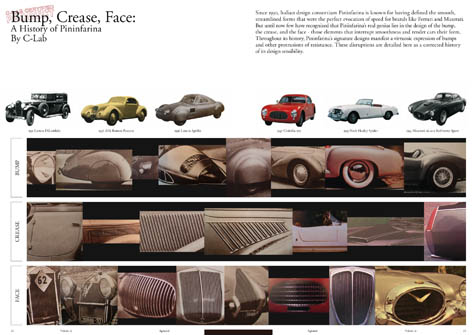 [Image: A page-spread from Volume 10].BLDGBLOG [Image: A page-spread from Volume 10].BLDGBLOG: And part of this agitation is your interest in the favela – the slum? In Volume 10 you published a whole travel guide to favelas, called Alibi. Inaba: Yeah. And it’s definitely not meant in an ironic way. The idea with Alibi was that you could produce urban research in the form of a travel guide, so that it could be readable for people other than architects. It was produced to raise architectural and urban issues – like dealing with water run-off, plumbing, garbage, and property boundaries – and to present that in a format digestible to others. In that sense, the genre of a travel guide is intentionally meant as a way to convey architectural information. 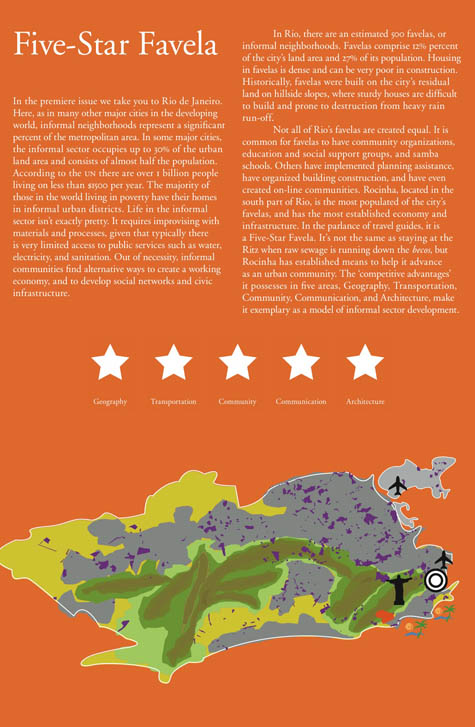 [Image: The cover page of Alibi, from Volume 10. For more on favelas, meanwhile, don't miss BLDGBLOG's earlier, two-part interview with Mike Davis].BLDGBLOG [Image: The cover page of Alibi, from Volume 10. For more on favelas, meanwhile, don't miss BLDGBLOG's earlier, two-part interview with Mike Davis].BLDGBLOG: But why favelas, in particular? Inaba: You know, some of my other work has been on suburbia, and the thing that we’re more and more convinced by is that the 21st century megacity will be a space – or urban condition – not defined by 20th century concepts of density or urbanity. Instead, it will be determined by two things: the suburb and the favela – the informal. You can think of LA as a proto-condition for this. But the places experiencing new architectural forms, new types of rapid growth, alternative patterns of collective development, extreme forms of communication, and a concern for planning stemming from necessity – these are all now happening in areas that are suburban, in areas that are informal. And that includes favelas. These are the generative elements of the 21st century city. 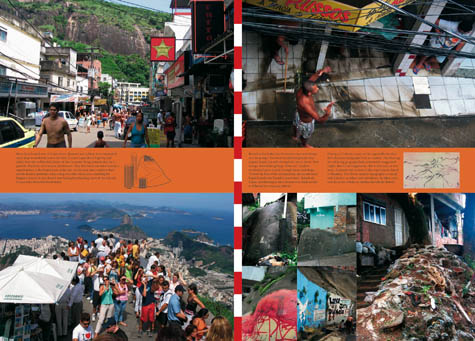 [Image: A page-spread from Volume 10].BLDGBLOG [Image: A page-spread from Volume 10].BLDGBLOG: Favelas are architecturally interesting – but they’re economically generated. In other words, the architecture – the space – comes second. So where does the favela actually come from? Is a favela formed from the bottom-up, as an organic outgrowth of local conditions? Or is it formed from the top-down – as a kind of architectural symptom of globalization and economic inequality? Inaba: That’s a really good question. You can find conditions in LA that you might think would be more typical of Mexico City, Cairo, or Lagos – and, yeah, I think you can read that through global capital flows, in the sense that now you have informal communities and suburbs next to one another, covering more area of the world than earlier forms of the city – like Manhattan, London, or Paris. I’m not so interested in whether it’s top-down or bottom-up – or bottom-down, for that matter – but in acknowledging that there is more of it in the world now than there are 20th century downtowns. BLDGBLOG: So these informal spaces and cities are sort of self-organizing? They generate more of themselves? They’re both productive and fractal? Inaba: I don’t see favelas as being self-organizing, or that favelas should be celebrated for their spatial innovation – not at all. Nor do I think of the favela only as a victim of flows of capital investment. What is interesting is that despite the potential of great amounts of capital to eradicate, favela urbanism is indestructible. It can exist right next to a central, concentrated corporate development. The only other thing that I can think of like that is the suburb. The two have persistence – an ability to absorb growth and destruction. That used to be what was thought of as unique to the 20th century city. This alone merits why the suburb and favelas needs to be addressed in architecture schools. 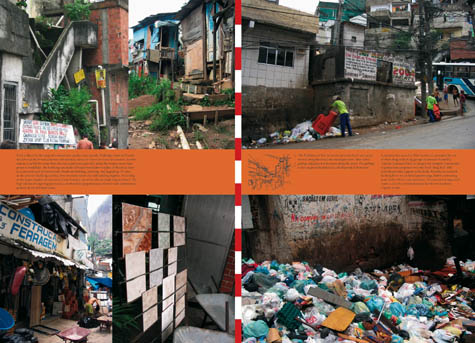 [Image: A page-spread from Volume 10].BLDGBLOG [Image: A page-spread from Volume 10].BLDGBLOG: Perhaps you should train architecture students in suburban development! At the very least, that would shine a more architecturally interesting and creative light on all those cul-de-sacs. Inaba: Another way to put it is that architectural form – what students learn and practice, what architectural programs produce – is focused on one marketplace: the marketplace of building design, not the marketplace of urban development. If the city is more complex and harder to understand at this given moment, because of globalization and environmental pressures, then – now more than ever – architects should be trying to explain it. I’m not sure that the technological investigation of form is the best use of our energy right now. Now should be the very moment when we try to describe what the city is. It seems that advances in architectural form, as an expression of the contemporary moment, doesn’t in itself help to explain or understand these things. BLDGBLOG: Changing tack a bit, in Great Leap Forward, much is made of feng shui, golf courses, and the idea of “politics, geography, and spirituality.” Could you tell me a bit more about your interest in this? I’m particularly drawn to the idea of “bad” feng shui – China’s building boom takes on a whole new meaning in this context. Inaba: Today, in China, environmentalism – meaning eco-friendly cities – is the expression of “politics, geography, and spirituality.” Branding a development as environmentally friendly is both a marketing tool and a political enabler for even greater development. Urban development in the name of environmentalism, and in the name of eco-friendly urbanism, could very well become the pretext for doing certain types of development that don’t actually reduce the rate of resource consumption: they set up conditions for even more rapid consumption, in the name of being politically, geographically, and spiritually sensitive. Sustainable development is becoming an unquestioned process, embraced as a positive form of urbanism. It’s being over-used. In that way, it’s producing landscapes of bad feng shui. BLDGBLOG: So, to some extent, feng shui really just means environmentally friendly? Inaba: [ laughs] Totally. BLDGBLOG: Sustainability also lends a kind of critical immunity to new building projects – if something's sustainable, no one wants to critique it. Being carbon neutral is like being handed an aesthetic Get Out of Jail Free card. Inaba: That’s exactly it – it’s irreproachable as a moral position. For example, Shenzhen has been criticized for being bad urbanism, based on the grounds of taste; it’s said to be ill-planned, quickly developed, and with poorly designed buildings. Meanwhile, other cities are deemed to be better examples of urbanism because of their environmental sensitivity – having a low carbon footprint – but, as such, they’re exempt from other criteria of judgment. One of the main features of eco-friendly design is its predisposition for suburb-like developments. In order to get large cities to accommodate large populations, in an environmentally sensitive way, why is it that all the projects result in a default language of green space and detached, single-family dwellings? One of the ways that suburbia is emerging in the megacity is through the rhetoric of ecology: an urbanism of eco-friendly villas. It’s like Laguna Niguel. [ laughs] Only it’s happening in China. 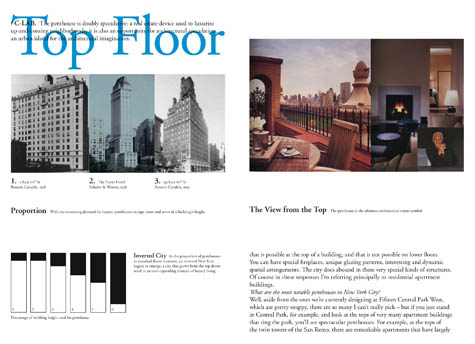 [Image: A page-spread from Volume 6].BLDGBLOG [Image: A page-spread from Volume 6].BLDGBLOG: C-Lab has also produced some great work around the idea of excess space, or a kind of spatial surplus. For instance, you interviewed Robert A.M. Stern in Volume 6, and he points out that the quintessential sign of Manhattan luxury living – the penthouse – is actually just an unintended result of extra building space. The penthouse is a creative reuse of leftovers, so to speak. Could you talk about this a bit? Inaba: There was an article in New York magazine by Jay McInerney about Tribeca now being the most expensive area in New York City – and, for that reason alone, there are people on the Upper East Side who want to move there. BLDGBLOG: [ laughter] Inaba: His point is that it’s not because of the quality of Tribeca’s architecture, or because of the kinds of spaces you can buy there, or because of the urban experience. If design is said to add value, then it seems to add only fractional value: concentrated high real estate value adds value. One of the things that’s also clear is that Tribeca now has the most penthouses. What we wanted to show is that there is a new distribution in the luxury residential building type that responds to the demand for excessive space. If the penthouse used to be the top floor – one floor more exclusive than the other floors – then buildings now have multiple floors of penthouses: they are mostly “penthouses.” The piece shows that some buildings have more “penthouses” than non-penthouses. Besides just chronicling this excess, we wanted to talk about our inaccessibility as a profession to this level of the city. There is a whole urban experience that we, as architects, don’t have access to. We don’t move in the same spaces, or social circles, or economic spheres. I, myself, don’t know anyone who manages a hedge fund; I don’t know, let alone dine with anyone in the private equity banking business who became super-super-mega-wealthy after Sarbanes-Oxley; I don’t have any access to that. BLDGBLOG: How does one engage with that, though? Do you organize a house tour, or a photo essay, or some kind of conference between hedge fund managers and their architects, or...? Inaba: It’s not an issue of gaining entry to this layer of New York for the benefit of architectural commissions, but to understand the economy and spaces of this New York, to be able to grasp what urbanism is today. Architects can’t be involved in urbanism if we can’t experience it. Just to reiterate the point: the city is going through a transformation where the most powerful economic stratum is not palpable on the street. In New York, during the banking boom of the late-80s and the tech boom of the 90s, feverish consumption and extreme wealth were evident. But this current period of even greater accumulation is hardly visible. Goldman Sachs gave out $19 billion in bonuses last year – but we don’t see the presence of that wealth in the general urban experience of New York. So the general issue is less a matter of shaking hands with private equity guys, but figuring out how to respond to our professional dislocation from the city. 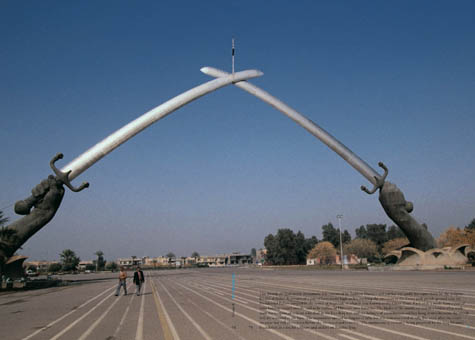 [Image: A page-spread from Volume 6].BLDGBLOG [Image: A page-spread from Volume 6].BLDGBLOG: In some ways, that reminds me of your interview with Kanan Makiya, also from Volume 6, about Baathist architecture. Saddam’s palaces, in a funny way, look like something Donald Trump might build – a kind of baroque desert penthouse. Is there a dictatorial vernacular emerging in architecture today? Inaba: Actually, Benedict Clouette did that interview – it’s really good. When we were looking at the material later, we were both struck by how humanistic those buildings made Saddam look! [ laughs] Meaning that the architecture of state power and the architecture of first world residences don’t seem that far apart. Saddam’s palaces, while they’re really supposed to be about state power, look not so different from houses in New Jersey. And the scale now of residential buildings isn’t so different from the scale of buildings that were once meant to symbolize state power, on an institutional scale. The dictatorial vernacular is not so far off from the American suburban vernacular. 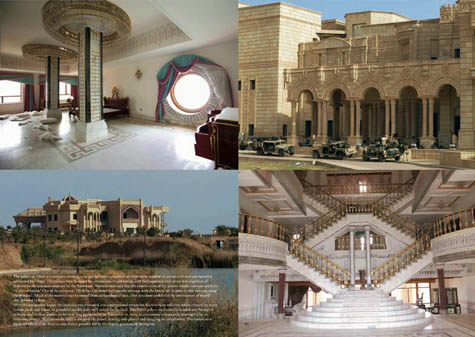 [Image: Two pages from Volume 6].BLDGBLOG [Image: Two pages from Volume 6].BLDGBLOG: So the palace of the dictator is a kind of McMansion in the desert? Inaba: Yeah – the scales are the same. It’s a vernacular that could as easily be used in Arizona as by a Baathist regime. BLDGBLOG: Finally, how did you end up interviewing Cesar Millan, the “ dog whisperer,” for Volume 10? Inaba: It’s one of my favorite pieces that we’ve ever done. To some degree, it’s about the relationship between an animal sense and a human sense of the world, and Cesar’s ability to formulate that into a viable political message. He seems to be a person who would be an interesting politician for the US today, because he is overtly advocating domination – the way one animal dominates another within a pack. And, in fact, he wants to run for office. His point is that, today, the UK and the US are run by weak leaders, leaders who are unstable, who don’t have enough discipline, and who don’t produce stability. By soliciting fear, they produce instability. So the way to respond to that is to create a clear form of dominance. For Cesar, assertiveness and physicality – the way a pack leader dominates a pack – is the type of logic that he wants to extend into politics. And he’s serious about it. If his initial popular appeal is that his methods are about this type of training exercised on your dog, I think the appeal of his show – which goes beyond dog owners – is that it affirms assertiveness in humans. It’s about the individual’s ability to be assertive. I think it’s noteworthy to publish him because he wants to extend this onto a political level. For him, domination, physical assertiveness, discipline – these are all forms of a higher level of affection.  [Image: A page from Volume 10].BLDGBLOG [Image: A page from Volume 10].BLDGBLOG: The cruel father. Inaba: In that sense, it’s not related to the urban, or to architecture; but we thought it was a really good articulation of a strategy of power – and so it was relevant to Volume magazine. BLDGBLOG: Actually, one more question: I’m curious what you think about using other genres for architectural research. It seems that everyone today just writes long, footnoted articles for the same handful of academic journals – then they complain about lack of audience. But why don’t they write science fiction novels, or comic books, or even screenplays? Or a blog, for that matter? Do you think that these other, less traditional genres have any value for the future of architectural research? Inaba: Absolutely. I think the point of issue 10 is that, for all the investment in architectural aesthetics at the moment, it seems like the terms that we use to discuss or define those aesthetics are surprisingly limited. We only have a few words to describe architectural form. By thinking through different genres – and their terms – we could expand our aesthetic vocabulary. So you could operate on the level of a science fiction novel – but you could just as well embrace the travel guide, or the interview, or the photo-collage. These things, by their very diversity, have the ability to generate a range of aesthetics. We want to operate in other guises. When you look at a place through the lens of a travel guide, there are things about architecture that can be deciphered and explained with greater ease. I think what’s important is our ability to extract things from the genre of science fiction, not to reproduce the look and feel of science fiction as a genre. As architects, we can go beyond aesthetics – in the sense of beautiful buildings, or interesting buildings, or new buildings – and find public consequences both for architecture and architectural discussion. • • •Thanks to Jeffrey Inaba, for the conversation and for inviting me to critique some student projects at SCI-Arc this week, and to Benedict Clouette for setting all these interviews up in the first place.
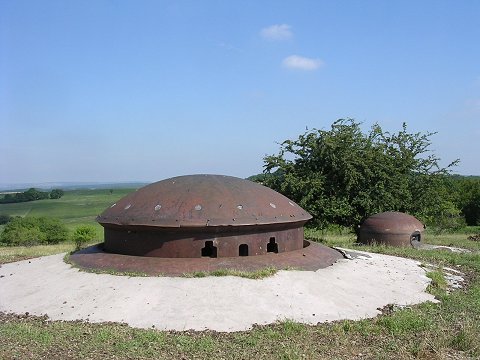 [Image: A turret on the Maginot Line]. [Image: A turret on the Maginot Line]."As I have said many times before," Paul Virilio states in an old interview with CTheory, "I was among the first people to experience the German Occupation of France during the Second World War. I was 7-13 years old during the War and did not really internalise its significance." 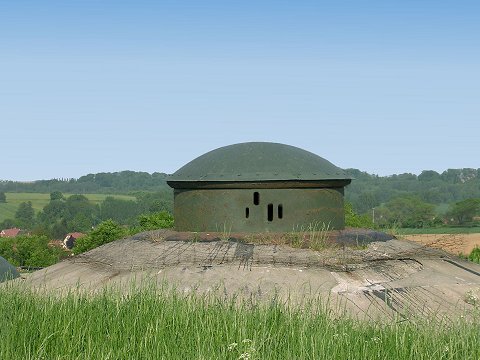 [Image: The Maginot Line]. [Image: The Maginot Line]."More specifically," Virilio continues, "under the Occupation, we in Nantes were denied access to the coast of the Atlantic Ocean. It was therefore not until after the War was over that I saw the sea for the first time, in the vicinity of St. Nazaire. It was there that I discovered the bunkers." 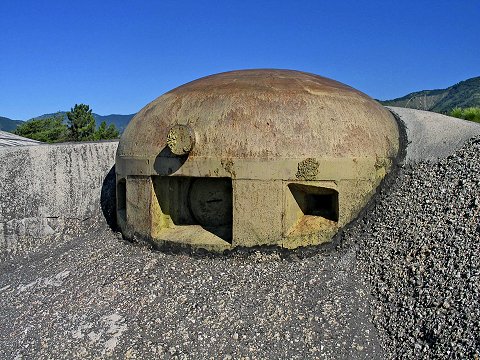 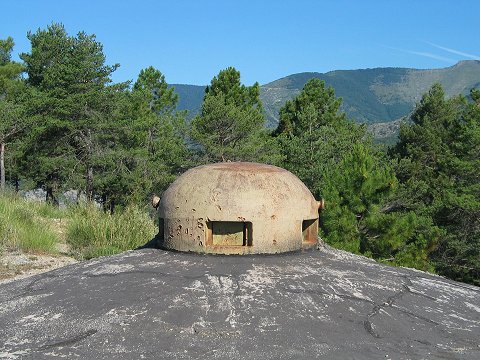 [Images: The Maginot Line – and, yes, I am aware that these are not the bunkers at St. Nazaire that Virilio just mentioned]. [Images: The Maginot Line – and, yes, I am aware that these are not the bunkers at St. Nazaire that Virilio just mentioned]."But what I also discovered was that, during the War, the whole of Europe had become a fortress. And thus I saw to what extent an immense territory, a whole continent, had effectively been reorganised into one city..." War, in Virilio's formulation, was thus a kind of terrestrial reorganization – a reshaping of the Earth's surface; it was, among other things, landscape architecture pursued by other means. 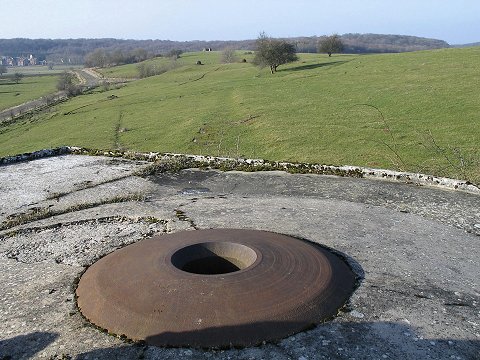 [Image: The Maginot Line].(Thanks, Scott! Earlier on BLDGBLOG: Bunker Archaeology). [Image: The Maginot Line].(Thanks, Scott! Earlier on BLDGBLOG: Bunker Archaeology).
 [Image: A detail from Abgang, 2000, by Thomas Demand, a photograph now on display at the Irish Museum of Modern Art. "Although his large-scale photographs seem to capture specific places," Artkrush explains, referring to Thomas Demand, "they actually document large-scale models constructed in the artist's Berlin warehouse studio." To date, these "large-scale models" have included "the site of Princess Diana's death, Saddam Hussein's 'spider hole,' and a standard staircase." Demand, along with Oliver Boberg, popped up on BLDGBLOG back in 2005]. [Image: A detail from Abgang, 2000, by Thomas Demand, a photograph now on display at the Irish Museum of Modern Art. "Although his large-scale photographs seem to capture specific places," Artkrush explains, referring to Thomas Demand, "they actually document large-scale models constructed in the artist's Berlin warehouse studio." To date, these "large-scale models" have included "the site of Princess Diana's death, Saddam Hussein's 'spider hole,' and a standard staircase." Demand, along with Oliver Boberg, popped up on BLDGBLOG back in 2005].
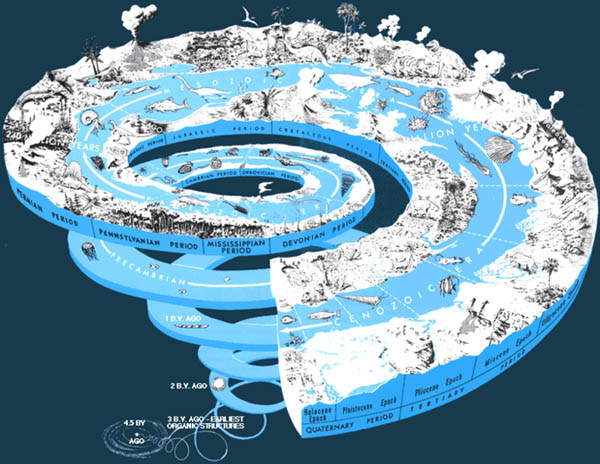 [Image: The geological time scale, in spiral form; via the USGS]. [Image: The geological time scale, in spiral form; via the USGS].Upon seeing the above diagram, it occurred to me that you could – or should – redesign the 10 Mile Spiral so that it communicates geological information. In other words, you could literally be driving up a diagram of the Earth's deep history. Vacationing families tootle their way around the spiral, eating ice cream cones – twisting in loops, upward through space – reading signs posted on either side about Precambrian tectonics... 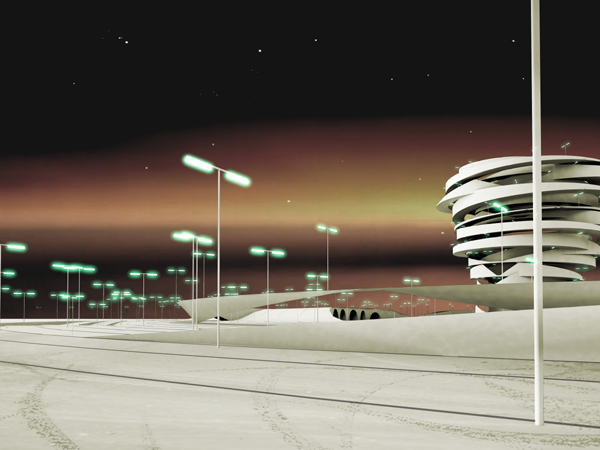 [Image: The 10 Mile Spiral, by Terraswarm]. [Image: The 10 Mile Spiral, by Terraswarm].At the very least, it would make the US highway system a bit more educationally worthwhile... Every off-ramp of I-95, for instance, would tell you a quick story: the discovery of edicarans, as you pull off to get gas; the rotational history of the North Pacific Gyre, explained to you at a Georgia rest-stop; outside New York City you read in awe, slowing down at a toll-booth, about the ancient reversal of the Amazon River... Signs like these proliferate, inspiring a whole new generation to take endless car trips: driving up and down the east coast of the United States, reading about geology. Soon, though, all those curious kids and their millions of cars emit so much carbon dioxide the Atlantic weather system shifts, plunging them all into an ice age... a planetary event that will someday be described on a sign and posted next to a highway in Kentucky. (Geo-spiral found via Leah Beeferman).
 [Image: Michael Benson, from Beyond, via the New York Times]. [Image: Michael Benson, from Beyond, via the New York Times].
The New York Times reports on Beyond, "a one-year exhibition of more than 30 large-format photographs of Earth’s planetary neighbors," opening soon at the American Museum of Natural History in New York. (For what it's worth, the AMNH is easily one of my favorite museums in the world; I couldn't count all the times I've been there.)
In any case, the New York Times explains that Michael Benson, "a writer, photographer and filmmaker, created the stunning series of pictures from the enormous archives of images taken over the years by robotic explorers of the solar system." Beginning in 1995 Mr. Benson spent years sifting through hundreds of thousands of photographs, looking for those that offered an aesthetic punch. He then painstakingly combined images, using digital tools like Photoshop, to eliminate dropouts and blurs from individual photos beamed back across millions of miles of space. A lovely picture of Europa, a moon of Jupiter, gliding in front of the swirling atmosphere of that planet, for example, is a blend of some 70 frames sent back by Voyager. Benson's got an entire book of these photographs, called Beyond: Visions of the Interplanetary Probes, complete with essays by Arthur C. Clarke and Lawrence Weschler. The book is very positively reviewed, being referred to as "breathtaking," "resplendent," "miraculous," "sublimely exhilarating," and "supremely reproduced." Best of all, from my end, I'll be in NY next month, so I'll get to see the show...
I was perhaps a little over-excited to see that Time Magazine included BLDGBLOG in its " Style & Design 100" list for 2007...  Other blogs on the list include Greenopia, Apartment Therapy, MoCo Loco, and designboom. I have to admit, though, to a certain amount of stunned optimism when a blog about Copernicus, Don DeLillo, science fiction and architecture, Mars, and... whatever this post was about makes it into Time Magazine. Does that mean, in other words, that there's some huge and untapped audience in the United States for articles about urban exploration, inflatable architecture, and W.G. Sebald? Are people in this country really looking for more information about micronations, offshore oil platforms, mud mosques, Greek myths, and futuristic outbreaks of statue disease? Does the U.S. secretly demand more Alpine thrillers...? It makes me really happy, actually, to think that people out there want to read about this stuff – this machine, for instance. Or this lost city. Amidst more news of Don Imus there's... the London Tornadium. And J.G. Ballard. Anyway, congrats to everyone on the list. Congrats to everyone, in fact – I'm in a good mood. Congratulations!
|
|
 [Image: Lake Agassiz, an ancient glacial lake whose draining may have changed the global climate].
[Image: Lake Agassiz, an ancient glacial lake whose draining may have changed the global climate]. [Image: The completely unrelated, but nonetheless beautiful, Arenal Volcano in Costa Rica].
[Image: The completely unrelated, but nonetheless beautiful, Arenal Volcano in Costa Rica]. [Image: The Sahara desert, waiting to spring upon the unsuspecting streets of Paris... Via Wikipedia].
[Image: The Sahara desert, waiting to spring upon the unsuspecting streets of Paris... Via Wikipedia]. [Image: The Northwest Passage, as imagined by Sir John Ross, 1819].
[Image: The Northwest Passage, as imagined by Sir John Ross, 1819].
 [Image: The solar-aligned ruins of Chankillo, Peru; via the
[Image: The solar-aligned ruins of Chankillo, Peru; via the  [Image: Photo by Ivan Ghezzi, demonstrating solar alignments with the "slightly curved spine" of the Thirteen Towers; via the
[Image: Photo by Ivan Ghezzi, demonstrating solar alignments with the "slightly curved spine" of the Thirteen Towers; via the  [Image: Like some kind of machine embedded in the surface of the earth, it's the Chankillo Observatory. Courtesy of GeoEye/SIME, via NASA's
[Image: Like some kind of machine embedded in the surface of the earth, it's the Chankillo Observatory. Courtesy of GeoEye/SIME, via NASA's  [Image: Via
[Image: Via  They can pay-to-stay:
They can pay-to-stay: [Image: Via
[Image: Via  [Image:
[Image:  [Image:
[Image:  [Image:
[Image:  [Image:
[Image:  [Image:
[Image:  [Image:
[Image:  [Image:
[Image:  [Image:
[Image:  [Image: The interior of the Pantheon, as photographed by
[Image: The interior of the Pantheon, as photographed by  [Image: A "celestogramme," looking up from within at the dome of the Pantheon, by
[Image: A "celestogramme," looking up from within at the dome of the Pantheon, by  [Image: Superimposition, by Walter Murch, of Copernicus's diagram of planetary orbits over a celestogramme of the Pantheon by
[Image: Superimposition, by Walter Murch, of Copernicus's diagram of planetary orbits over a celestogramme of the Pantheon by  As the Financial Times explained:
As the Financial Times explained: Elsewhere, sudden transformations of the earth's surface, as a result of mudslides, floods, volcanic eruptions, and other topographical catastrophes, can make existing maps obsolete within seconds.
Elsewhere, sudden transformations of the earth's surface, as a result of mudslides, floods, volcanic eruptions, and other topographical catastrophes, can make existing maps obsolete within seconds.  [Image: Alpine geothermics; illustration by
[Image: Alpine geothermics; illustration by  [Image: The hexagonal wooden islands of
[Image: The hexagonal wooden islands of  [Image:
[Image:  [Images: Concrete barriers (with no connection to Baghdad)].
[Images: Concrete barriers (with no connection to Baghdad)].  Even better, these "'coronal loops' carry acoustic waves in much the same way that sound is carried through a pipe organ." In the process, each micro-flare – released by coronal looping and fueled by "the energy equivalent to millions of hydrogen bombs" – sends "immensely powerful acoustic waves hurtling through the loops at tens of kilometres per second, creating cosmic 'organ music'."
Even better, these "'coronal loops' carry acoustic waves in much the same way that sound is carried through a pipe organ." In the process, each micro-flare – released by coronal looping and fueled by "the energy equivalent to millions of hydrogen bombs" – sends "immensely powerful acoustic waves hurtling through the loops at tens of kilometres per second, creating cosmic 'organ music'." Mixing our musical metaphors here, the sonic effect is then compared to plucking a guitar string – but, judging from
Mixing our musical metaphors here, the sonic effect is then compared to plucking a guitar string – but, judging from  I would even postulate, given the evidence, that we can only understand the sun through metaphors – comparing it to scientific models, hydrogen bombs, musical instruments, gods and goddesses, etc. – which, as it happens, is the subject of a short essay by Jacques Derrida called "
I would even postulate, given the evidence, that we can only understand the sun through metaphors – comparing it to scientific models, hydrogen bombs, musical instruments, gods and goddesses, etc. – which, as it happens, is the subject of a short essay by Jacques Derrida called " [Images: The Zadar sea organ, from this
[Images: The Zadar sea organ, from this  [Image: Jeffrey Inaba].
[Image: Jeffrey Inaba]. [Image: A page-spread from Volume 10].
[Image: A page-spread from Volume 10]. [Image: The cover page of Alibi, from Volume 10. For more on favelas, meanwhile, don't miss BLDGBLOG's earlier, two-part interview with
[Image: The cover page of Alibi, from Volume 10. For more on favelas, meanwhile, don't miss BLDGBLOG's earlier, two-part interview with  [Image: A page-spread from Volume 10].
[Image: A page-spread from Volume 10]. [Image: A page-spread from Volume 10].
[Image: A page-spread from Volume 10]. [Image: A page-spread from Volume 6].
[Image: A page-spread from Volume 6]. [Image: A page-spread from Volume 6].
[Image: A page-spread from Volume 6]. [Image: Two pages from Volume 6].
[Image: Two pages from Volume 6]. [Image: A page from Volume 10].
[Image: A page from Volume 10]. [Image: A turret on the
[Image: A turret on the  [Image: The
[Image: The 
 [Images: The
[Images: The  [Image: The
[Image: The  [Image: A detail from Abgang, 2000, by
[Image: A detail from Abgang, 2000, by  [Image: The geological time scale, in spiral form; via the
[Image: The geological time scale, in spiral form; via the  [Image: The
[Image: The  [Image: Michael Benson, from
[Image: Michael Benson, from  Other blogs on the list include
Other blogs on the list include 


